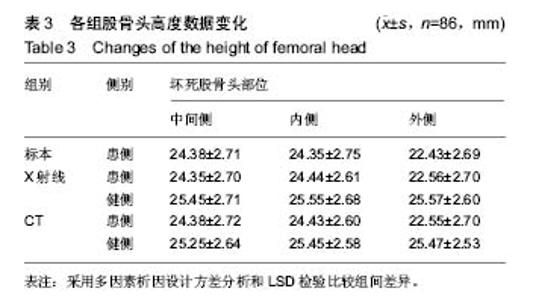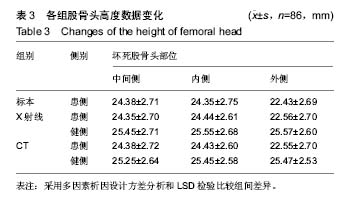| [1] Burian M, Dungl P, Chomiak J, et al. Operative Treatment for Saddle-Shaped Femoral Heads. Acta Chir Orthop Traumatol Cech. 2016;83(4):247-253. [2] Amstutz HC, Le Duff MJ. Hip resurfacing for osteonecrosis: two- to 18-year results of the Conserve Plus design and technique. Bone Joint J. 2016;98-B(7):901-909. [3] Kuroda Y, So K, Goto K, Matsuda S. Extremely early stage osteonecrosis of the femoral head in a patient with hip pain secondary systemic steroid pulse therapy for Vogt-Koyanagi-Harada syndrome: a case report. Int J Surg Case Rep. 2016;25:97-101. [4] Church DJ, Merrill HM, Kotwal S, et al. Novel Technique for Femoral Head Reconstruction using Allograft following Obturator Hip Dislocation. J Orthop Case Rep. 2016;6(1): 48-51. [5] Fuchs B, Knothe U, Hertel R, et al. Femoral osteotomy and iliacgraft vascrlarization for femoral head osteonecrosis .Clin Orthop. 2003;(412):84-93.[6] Sonoda K, Motomura G, Kawanami S, Takayama Y, Honda H, Yamamoto T, Nakashima Y. Degeneration of articular cartilage in osteonecrosis of the femoral head begins at the necrotic region after collapse: a preliminary study using T1 rho MRI. Skeletal Radiol. 2017. doi: 10.1007/s00256-017-2567-z. [7] Won Y, Lee GS, Kim SB, et al. Osteochondral autograft from the ipsilateral femoral head by surgical dislocation for treatment of femoral head fracture dislocation: a case report. Yonsei Med J. 2016;57(6):1527-1530.[8] Zhang L, Sun X, Tian D, et al. Model establishment, mri and pathological features of early steroid-induced avascular necrosis of femoral head in rabbit. Zhongguo Xiu Fu Chong Jian Wai Ke Za Zhi. 2015;29(10):1240-1243. [9] Jiang W, Wang P, Wan Y, et al. A simple method for establishing an ostrich model of femoral head osteonecrosis and collapse. J Orthop Surg Res. 2015;10:74. [10] 康鹏德,裴福兴.早期股骨头坏死(FicatⅠ、Ⅱ期)的治疗[J].中国骨与关节损伤杂志,2010,25(1):91-94.[11] Cherian SF, Laorr A, Saleh KJ, et al. Quantifying the extent of femoral head involvement in osetonecrosis. J Bone Joint Surg (Am). 2003;85:309-315.[12] Kim YH, Ahn JH, Kang HS, et al. Estimation of the extent of osetonecrosis of femoral head using MRI. J Bone Joint Surg (Br). 1998;80:954-958.[13] Nihii T, Sugano N, Ohzono K, et al. Significance of lesion size of location in the prediction of collapse of osteonecrosis of the femoral head: a new three-dimensional quantification using magnetic resonance imaging. J Orthop Res. 2002;20: 130-136.[14] Ficat RP. Idiopathic bone necrosis of the femoral head. Earlydiagnosis and treatment. J Bone Joint Surg (Br). 1985;67:3-9.[15] 李子荣.股骨头骨坏死的ARCO分期[J].中华外科杂志, 1996, 34(3):186-187. [16] Pascart T, Falgayrac G, Migaud H, et al. Region specific Raman spectroscopy analysis of the femoral head reveals that trabecular bone is unlikely to contribute to non-traumatic osteonecrosis.Sci Rep. 2017;7(1):97. [17] Lakhotia D, Swaminathan S, Shon WY, et al. Healing Process of Osteonecrotic Lesions of the Femoral Head Following Transtrochanteric Rotational Osteotomy: A Computed Tomography-Based Study. Clin Orthop Surg. 2017;9(1):29-36. [18] Ma HZ, Zhou DS, Li D, et al. A histomorphometric study of necrotic femoral head in rabbits treated with extracorporeal shock waves. J Phys Ther Sci. 2017;29(1):24-28. [19] Roos BD, Assis MC, Roos MV, et al. Arthroscopic subcapital realignment osteotomy in chronic and stable slipped capital femoral epiphysis: early results. Rev Bras Ortop. 2016;52(1): 87-94.[20] Chen Y, Nan Y, Jirong S, et al. Clinical reports of surgical dislocation of the hip with sequestrum clearance and impacting bone graft for grade IIIA-IIIB aseptic necrosis of femoral head (ANFH) patients. Oncotarget. 2017. doi: 10.18632/oncotarget.15095.[21] Morita D, Hasegawa Y, Okura T, et al. Long-term outcomes of transtrochanteric rotational osteotomy for non-traumatic osteonecrosis of the femoral head. Bone Joint J. 2017; 99-B(2):175-183. [22] Zhang Q, Liu L, Sun W, et al. Extracorporeal shockwave therapy in osteonecrosis of femoral head: a systematic review of now available clinical evidences. Medicine (Baltimore). 2017;96(4):e5897. [23] Seol PH, Ha KW, Kim YH, et al. Effect of Radial Extracorporeal Shock Wave Therapy in Patients With Fabella Syndrome. Ann Rehabil Med. 2016;40(6):1124-1128.[24] Sonoda K, Motomura G, Kawanami S, et al. Degeneration of articular cartilage in osteonecrosis of the femoral head begins at the necrotic region after collapse: a preliminary study using T1 rho MRI. Skeletal Radiol. 2017;46(4):463-467.[25] Arai R, Takahashi D, Inoue M, et al. Efficacy of teriparatide in the treatment of nontraumatic osteonecrosis of the femoral head: a retrospective comparative study with alendronate. BMC Musculoskelet Disord. 2017;18(1):24. |

